Manage Your Stock Items
Does your business involve stock items or inventory in the day-to-day transactions? If so, you certainly need to manage and keep track of all your stocks – how much of them have been sold every day, what is the balance stock, are the stocks moving as per the demand, do you have too much unused stock and so on. In TallyPrime, you can create as many stock items as you have in the business, specify units of measurements (UoMs) for each stock item and define tax rates, without having to enter these details again during transactions.
Whether you keep your stocks in different groups, batches or godowns, based on your business practices, you can find the details of your stock items any way you need. Real-time view of your stock quantity helps to refill your stock in advance to avoid the risk of losing customers, You can also view stock item reports for each group or batch as needed.
Create & use stock items: Like other masters in TallyPrime, such as ledgers, godowns, stock groups, and so on, you can create stock items by providing a few details. Just enter the name of the stock item and you are done! You can set up details such as Unit of Measurement (UoM) and tax rates any time later. You can also define quantity, rate, and value as the opening balance of your stock.
Once you create a stock item and use it in your transactions, reports in TallyPrime start tracking the stock item – sales or purchase transactions that include that stock item, number of stock items sold from period to period, overall stock position of your business, and so on.
Group your stock items: Having a stock group is not mandatory to create a stock item in TallyPrime. If you have been maintaining your stock items without creating any Stock Group, TallyPrime considers all stock items under an internal group called Primary.
However, if you keep your stock items in different groups depending on any of their common features such as brand, product type, or size, use the Stock Group feature in TallyPrime. For example, stock items made of the same fabric – say synthetic – can be under one stock group and stock items with cotton fabric can be in a different group. This will not only help to organise the stock items but also provide a consolidated view of the stock items with you.
In certain cases, stock items from different groups also have a common property and therefore can be categorised across multiple stock groups, using Stock Categories.
For example, stock items made of synthetic fabric are sold at two different prices – TypeA_Ctt at Rs. 500 and TypeB_Ctt at Rs. 900. Similarly, synthetic stock items are sold as Type1_Syn for Rs. 900 and Type2_Syn for Rs. 500. In such cases, keeping the stock group as is, you can create stock category in TallyPrime to see the pricing wise grouping of stock items at the same time.
The items are classified into Cotton and Synthetic stock groups; at the same time, they are also classified as Items at Rs. 500 and Items at Rs. 900 – the stock categories in this case. Therefore, stock items TypeA_Ctt’ and ‘Type1_Syn’ (which are part of different stock groups) are viewed as part of the stock category – that is ‘Items @ Rs. 500’. This also helps you get an insight of how many stock items of a particular price is available or sold at a given time.
Know stock position of your business: Reports in TallyPrime can provide you details of your stock items in different ways. You can view stock position of your business based on the stock item groups and categories. Like any other reports in TallyPrime, stock item details can further be viewed for different periods, such as daily, weekly, monthly, quarterly or yearly, You can configure your reports to view stock items to each party your business deals with. Knowing the overall stock position of your business helps you to decide if you need to fill in the stock items, if items are moving fast or under a particular period or group and so on.
Stock Items
A stock item in TallyPrime is required to fill in information about the stock or inventory that your business deals with. Once you have created stock item, you can records your business transactions and keep track of the stock item details. Simply enter the name of the stock item you want to create and save it. Also, provide the opening balance details such as quantity, rate, value applicable tax rates so that you can record transactions in less time, without the need to enter all of these details each time in the transactions.
In this section
- Create stock items
- Tax rate of stock items
- Stock items in transactions
- Opening Stock and Closing Stock values
Create Stock Items
- Gateway of Tally > Create > type or select Stock Item > and press Enter.
Alternatively, press Alt+G (Go To) > Create Master > type or select Stock Item > and press Enter. - Name & alias: As in other masters, you can specify multiple aliases for the stock item.
- Under: Select Primary or an existing Stock Group. If you have not created any Stock Group, you can create one in TallyPrime to assign to the stock item.
As always, press Alt+C, to create a master on the fly. Alternatively, press Alt+G (Go To) > Create Master > type or select Stock Items > press Enter. - Units: Select the unit of measurement applicable for the stock item. If the unit is not listed, you can create the unit of measurement in TallyPrime to assign to the stock item.
As always, press Alt+C, to create a master on the fly. Alternatively, press Alt+G (Go To) > Create Master > type or select Units > press Enter.
- All the UQCs declared by the government or GSTN are available in TallyPrime by default. You can select based on relevance to the product or commodity. Whenever there is a new UQC declared by GSTN that TallyPrime has not provided, or you are yet to upgrade, you can create a new UQC with the exact name and symbol as defined by GSTN. Altering the defined name or UQC is not possible. However, you can create a new UQC.
- Unit Creation > Unit Quantity Code (UQC) > select New UQC.
- Enter the UQC Name, and press Enter.
- All the UQCs declared by the government or GSTN are available in TallyPrime by default. You can select based on relevance to the product or commodity. Whenever there is a new UQC declared by GSTN that TallyPrime has not provided, or you are yet to upgrade, you can create a new UQC with the exact name and symbol as defined by GSTN. Altering the defined name or UQC is not possible. However, you can create a new UQC.
- Statutory Details: Set the applicable Taxability option for the stock item under Statutory details, The option will depend on the option enabled in the F11 (Features) screen. Click here to see more.
- Opening Balance: Specify the opening balance for the Stock Item as on the date of Beginning of Books.
- Quantity: Specify the stock item Quantity.
- Rate: Specify the stock item Rate.
- Value: TallyPrime automatically calculates the value by multiplying the Quantity and Rate. You can also edit the value, TallyPrime automatically refreshes the Rate field accordingly.
- Accept the screen. As always, press Ctrl+A to save.
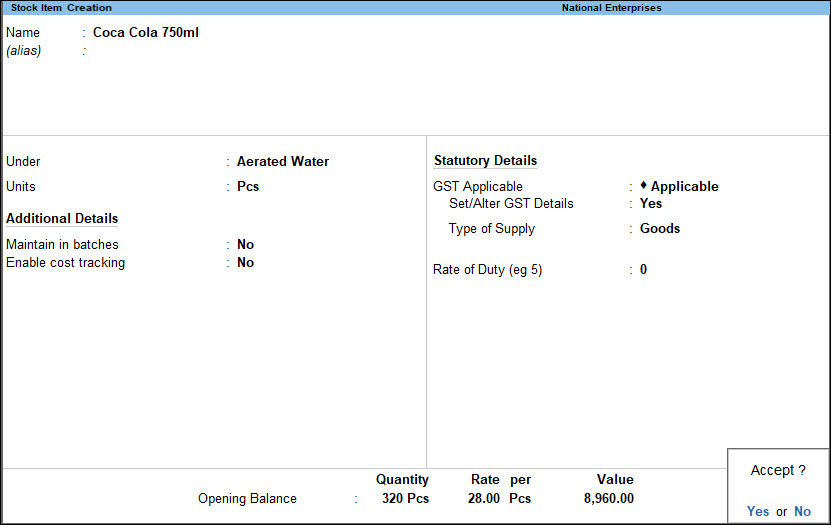
For the F12 configurations of Stock Item, click here.
Tax rate of stock items
Stock items attract different tax rates as per the department. Business dealing with stock items need to consider the applicable tax rates in their transactions. To do so, you can set up the tax rate details for the stock items in TallyPrime. The details your enter for the stock items will be automatically considered for calculation in your transactions.
When creating or altering the stock item master
- In the Stock Item master, press F12 (Configure) > Set GST Details to Yes.
- If you do not see this option, ensure that Enable Goods and Services Tax (GST) is set to Yes in F11 for your company.
- If you need to use this option only for the current master, Press Ctrl+I (More Details) > type or select GST Details > and press Enter.
In case the option is inactive, you will be prompted to enable the GST feature for your Company. Select Yes or press Y to proceed.
- GST Applicable: Select Applicable, if the stock item is eligible for tax calculation.
- Set/alter GST Details: Set to Yes to enter the tax details for your stock items as it is followed in your business. In TallyPrime, you can add tax rates in different ways.
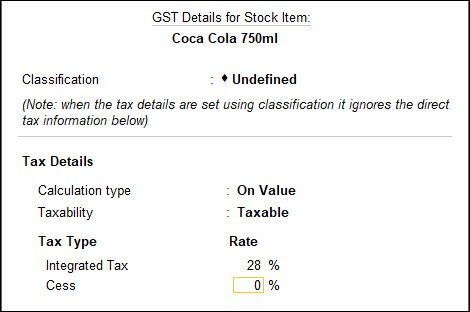
Stock items in transactions
- Gateway of Tally > Vouchers > press F8 (Sales).
Alternatively, Alt+G (Go To) > Create Voucher > press F8 (Sales). - After you select the stock item in the Name of Item field and press Enter, in the Stock Item Allocations screen, select the Godown, Quantity, and Rate.
The Amount will get calculated automatically. - Complete the transaction by entering other details, and accept the voucher. As always, you can use Ctrl+A to save.
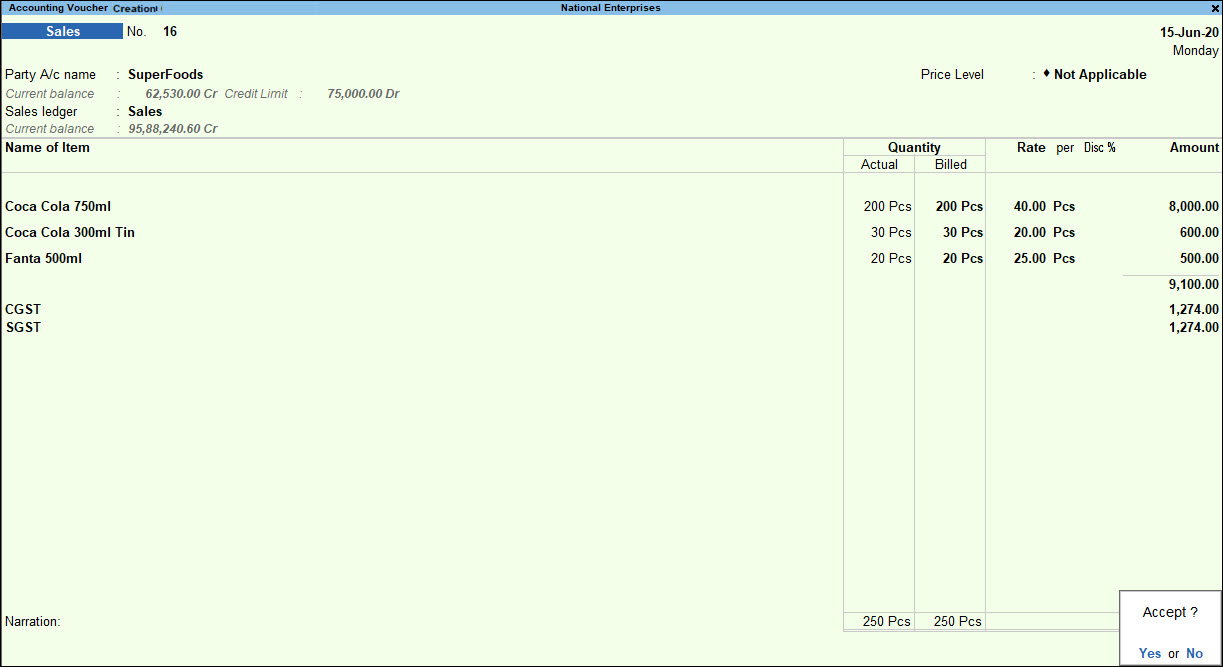
Opening Stock and Closing Stock Values
In your business, there may be situations when you will find discrepancies in the actual amount of stock in your godown or shop and the amount recorded in the system due to inventory shrinkage, mismanagement of returns, misplacement of stock items, and other human errors. In such cases, you can enter the actual opening and closing stock for the stock item separately.
- Create a ledger for the stock item under Stock-in-Hand group.
- Alt+G (Go To) > select Create Master > select Ledger > press Enter.
Alternatively, Gateway of Tally > Create > select Ledger > press Enter. - Enter the name of stock item.
- In the Under section, type or select Stock-in-Hand > press Enter.
- Alt+G (Go To) > select Create Master > select Ledger > press Enter.
- Enter the amount corresponding to Opening Balance.
- Accept the screen. As always, press Ctrl+A to save.
- Enter Closing Balance.
- Alt+G (Go To) > select Alter Master > select Ledger > select the ledger you created for stock item > press Enter.
- Enter the Date and Closing Balance value. Press Ctrl+A to save
To view the Opening and Closing Balances in your financial report
- Press F11 > set Integrated Accounts with Inventory to No.
- Press Alt+G (Go To) > select Profit & Loss A/c and check Opening Stock and Closing Stock values.
Classify Stocks Items in Groups and Categories
Managing stock items in groups help in easily locating them, especially when you need to track different stock items sharing a common feature – say a common brand, product type, material used, and so on. You can get a consolidated view of the total stock items available under that group. Stock items under a group need to have the same unit of measurement for consolidation and better management. This also helps in reporting of stock items group-wise in the financial statements.
In this section
Create Stock Groups
- Gateway of Tally > Create > type or select Stock Group and press Enter.
Alternatively, press Alt+G (Go To) > Create Master > type or select Stock Group > and press Enter. - Name & alias: As in other masters, you can specify multiple aliases for the stock item.
- Under: Select Primary or an existing Stock Group. If you have not created any Stock Group, you can create one in Tallyprime to assign to the stock group.
As always, press Alt+C, to create a master on the fly. Alternatively, press Alt+G (Go To) > Create Master > type or select Stock Group > press Enter. - Should quantities of items be added: It pertains to information on measuring the units of the Stock Items that you would categorise under the Stock Group. The Stock Items categorised under the group should have similar units for them to be added up. You cannot add quantities in Kgs to quantities in Pcs.
- Set/alter GST Details: Enable this option to define the GST rate.
- Accept the screen. As always, press Ctrl+A to save.
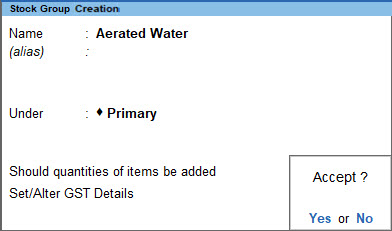
Click to see the F12 configurations for Stock Groups.
Create Stock Categories
Stock category offers a parallel classification of stock items, categorizing items is that you can classify the stock category based on functionality together in a group. You can classify the stock category across different stock groups which enables you to obtain reports on alternatives or substitutes for a stock item.
- Gateway of Tally > Create > type or select Stock Category and press Enter.
Alternatively, press Alt+G (Go To) > Create Master > type or select Stock Category > and press Enter. - Name & alias: As in other masters, you can specify multiple aliases for the stock item.
- Under: Select Primary or an existing Stock Group. If you have not created any Stock Group, you can create one in TallyPrime to assign to the stock categories.
As always, press Alt+C, to create a master on the fly. Alternatively, press Alt+G (Go To) > Create Master > type or select Stock Category > press Enter. - Accept the screen. As always, press Ctrl+A to save.
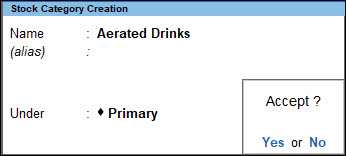
Click to see the F12 configurations for Stock Categories.
Track Stock Item Details Using Reports
Maintaining stock items will also need to know your stock positions based on different parameters – by period, by manufacturing and expiry dates, by stock groups, by age of your stock items and so on. Reports in TallyPrime provides all such details with real-time record of your stock position. You can also find out the last selling
or purchase price of the stock items as a reference to set up the price in the future. You can configure the reports to know the overall consumption and production or sort stock items or groups as you need for your business.
In this section
- Stock Summary
- Stock Group Summary
- Stock Category Summary
- Movement Analysis
- Ageing Analysis
- Stock Query
Stock Summary
The Stock Summary is a statement of the stock-in-hand on a particular date, and it updates the stock record real time. Stock Summary provides information on stock groups, and shows the quantity details, rate, and closing value of the stock items under each group. For more details, see Stock Summary.
Stock Group Summary
This report is available when the option Integrate Accounts with Inventory is set to No in the Company Features screen.
It displays Opening and Closing Stock figures from the ledger account master, rather than the inventory records. Hence, it is possible that Stock Summary and the Stock Group Summary report display different figures.
- Gateway of Tally > Profit & Loss A/c > select Opening Stock (or Closing Stock) and press Enter.
Alternatively, Alt+G (Go To) > Profit & Loss A/c > select Opening Stock (or Closing Stock) and press Enter. - Drill-down from Stock Group Summary to view the Stock Ledger account where you can manually key in the closing balance for a given date. You can enter the closing stock figures for different dates.
The date for the closing balance is the beginning from date and till date. If there is no date that follows the last, then that Closing Balance continues. A blank against a date signifies zero balance.
Stock Category Summary
The Stock Category Summary lists the Closing Balances of all items belonging to the selected category.
- Gateway of Tally > Display More Reports > Inventory Books > Stock Category Summary.
Alternatively, Alt+G (Go To) > type or select Stock Category Summary and press Enter. - Select a Category.
The Stock Category Summary screen appears as shown below: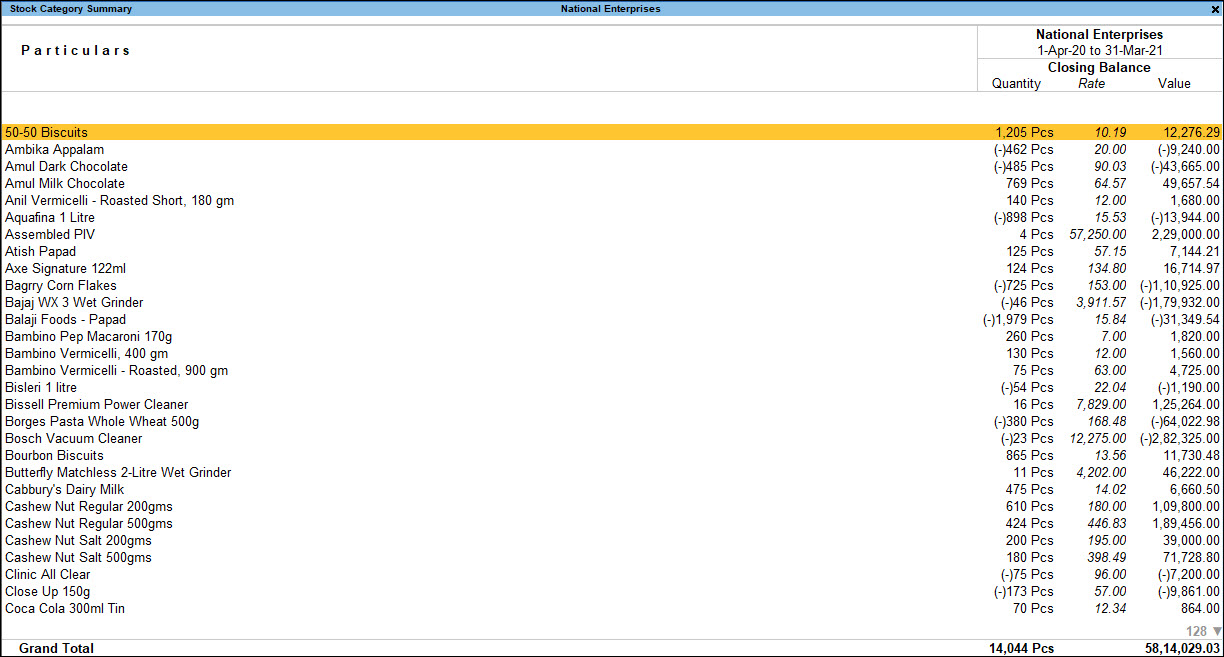
- You can Drill-down from stock category summary to display Stock Item Monthly Summary and Stock Voucher list.
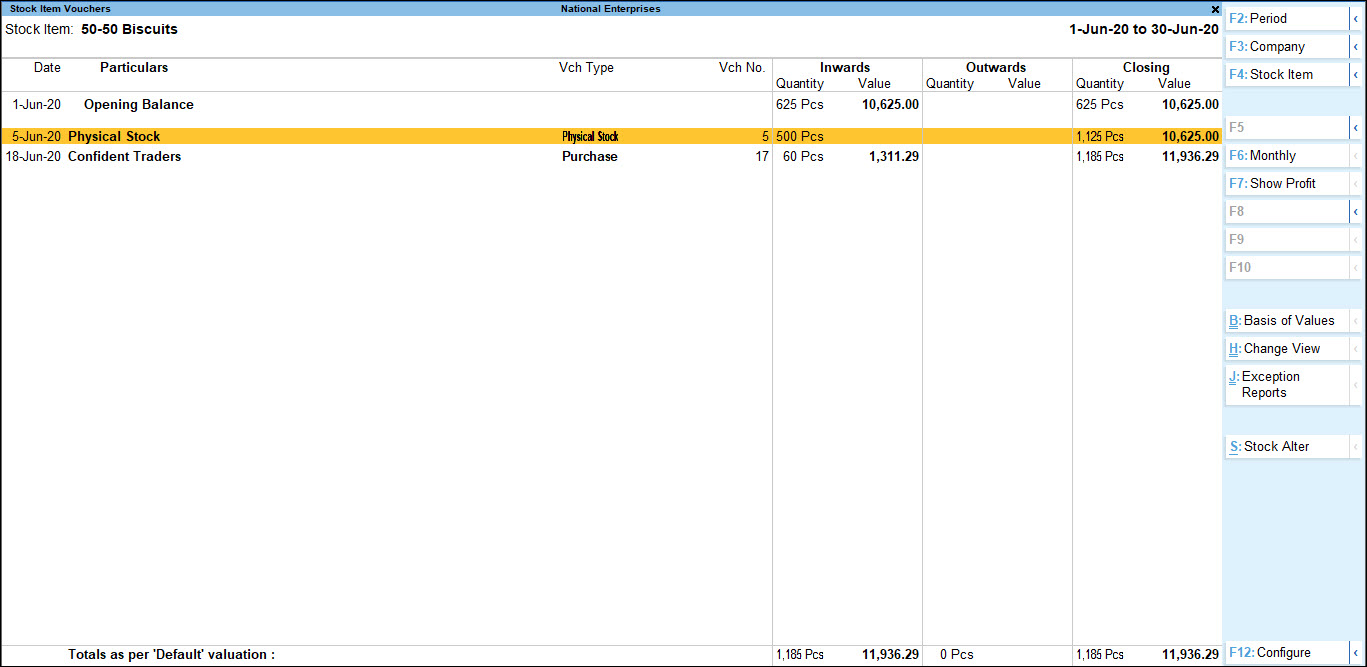
- Use Show Profit for profitability analysis for the Items in the Category.
- Press F7 (Show Profits) to expand the Outwards Column for Consumption and Profit figures.
Movement Analysis
Movement analysis shows the analysis of only those inventory transactions which are integrated with the accounts, i.e. inventories which are also recorded in the books of accounts. Inventory vouchers which affect the stock only in quantitative terms are not considered.
Movement analysis report is used for comparative studies. They give an insight into the flow characteristics of the stock in an organization. It also helps in finding out the slow moving items which cause blockages in the flow of the working capital of the organization. For more information, refer to Movement Analysis.
Ageing Analysis
Stock Ageing Analysis Report in TallyPrime displays the age of the stock-in-hand. This report lists the age-wise break-up of inventory to demarcate old stock. TallyPrime gives its users the flexibility to define their own ageing slabs. Ageing Analysis lists out items batch wise, that have already expired or may expire in the near future. This information will help you keep track of the age of stock and also quick moving inventory, as older stock may depreciate in value or become obsolete, and result in a loss. For more information, refer to Stock Ageing Analysis Report.
Stock Query
The Stock Query report provides complete information pertaining to a particular stock item. The details include Alias, Part No., Stock Group, Stock Category, available Closing Quantity & Balance, Cost Price, Std. Selling Price, Costing Method and Market Valuation Method, and so on. For more information, refer to Stock Query Report.